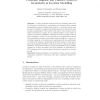1013 search results - page 84 / 203 » A Hierarchical Clustering Method for Semantic Knowledge Base... |
KI
2010
Springer
14 years 11 months ago
2010
Springer
Location models are data structures or knowledge bases used in Ubiquitous Computing for representing and reasoning about spatial relationships between so-called smart objects, i.e....
105
Voted
MDM
2004
Springer
15 years 6 months ago
2004
Springer
Location-based applications require a well-formed representation of spatial knowledge. Current location models can be classified into symbolic or geometric models. The former att...
130
Voted
BMCBI
2010
15 years 21 days ago
2010
Background: As the size of the known human interactome grows, biologists increasingly rely on computational tools to identify patterns that represent protein complexes and pathway...
117
Voted
IJHPCA
2002
15 years 8 days ago
2002
Distributed cognition of dynamic processes is commonly observed in mobile groups of animates like schools of fish, hunting lions, or in human teams for sports or military maneuvers...
82
Voted
SAC
2002
ACM
15 years 7 days ago
2002
ACM
Analyzing, structuring and organizing documented knowledge is an important aspect of knowledge management. In order to ease the access to text collections, in literature so-called...

